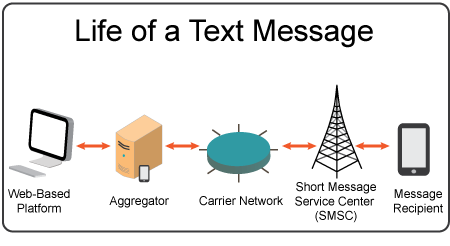How Do You Send Texts to Many People at Once?
When you text a friend, coworker, or family member, you are typically texting from one phone to another. If you are trying to text many people at the same time, you will most likely use a web-based application. This application allows you to send messages to your entire list of end-users or to subsets of that list. Most applications let you sort users and track messages.
How Does This Work?

Conceptually, sending SMS messages on a large scale has five steps.
- Using a web-based platform, the agency crafts a message to deliver to the end user's mobile device. Messages may also be sent through a mobile device.
- The message is submitted to the aggregator's SMS gateway. The aggregator is an SMS service provider that acts as an intermediary between users, recipients and the mobile carriers.
- The aggregator locates the recipient's carrier network and transmits the message to the carrier's Short Message Service Center (SMSC).
- The SMSC is the infrastructure responsible for sending and receiving SMS messages in a wireless carrier's network.
- The SMSC delivers the message to the recipient.
If the end user is not available, the carrier's SMSC stores the message until a later time for subsequent retransmission. Thus, SMS operates as a store-and-forward service unlike a voice call. Each carrier has different policies about how long they will hold a message, but after that period of time expires, the message is deleted. Occasionally an SMS text message delivery is delayed, or not delivered at all, particularly if an end user's phone is turned off for an extended period of time. Some other causes include:
- Network congestion
- The destination handset is beyond the coverage area
- The destination handset memory is full
- Outages in the service provider or network infrastructure
How Does This Work in an Emergency?
This store and forward delivery system is one reason why SMS is both more reliable—and less reliable—than voice during an emergency. During an emergency, voice lines can get jammed. SMS messages are more likely to go through because system overload can be mitigated by temporary message storage. However, some messages may not be stored long enough and may be lost—which is why some people think SMS is less reliable than voice.
Move ahead to learn more about choosing a web-based Application.


